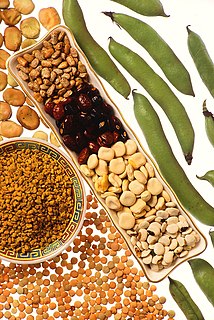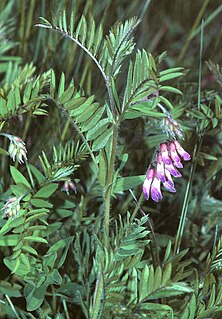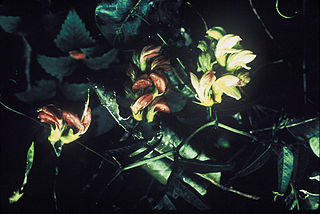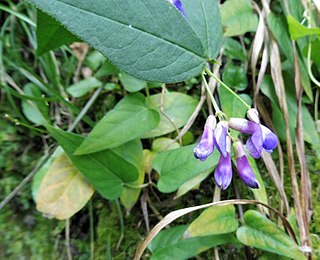Hairy vetch is a common name for several plants and may refer to:
- Vicia hirsuta
- Vicia sativa
- Vicia villosa , native to Europe and western Asia
Hairy vetch is a common name for several plants and may refer to:
Tare or Tares may refer to:

Vicia sativa, known as the common vetch, garden vetch, tare or simply vetch, is a nitrogen-fixing leguminous plant in the family Fabaceae. Although considered a weed when found growing in a cultivated grainfield, this hardy plant is often grown as green manure or livestock fodder.

Forage is a plant material eaten by grazing livestock. Historically, the term forage has meant only plants eaten by the animals directly as pasture, crop residue, or immature cereal crops, but it is also used more loosely to include similar plants cut for fodder and carried to the animals, especially as hay or silage.

Vicia faba, also known in the culinary sense as the broad bean, fava bean, or faba bean, is a species of flowering plant in the pea and bean family Fabaceae. It is widely cultivated as a crop for human consumption, and also as a cover crop. Varieties with smaller, harder seeds that are fed to horses or other animals are called field bean, tic bean or tick bean. Horse bean, Vicia faba var. equinaPers., is a variety recognized as an accepted name.

A legume is a plant in the family Fabaceae, or the fruit or seed of such a plant. When used as a dry grain, the seed is also called a pulse. Legumes are grown agriculturally, primarily for human consumption, for livestock forage and silage, and as soil-enhancing green manure. Well-known legumes include beans, soybeans, peas, chickpeas, peanuts, lentils, lupins, mesquite, carob, tamarind, alfalfa, and clover. Legumes produce a botanically unique type of fruit – a simple dry fruit that develops from a simple carpel and usually dehisces on two sides.

Vicia cracca, is a species of vetch native to Europe and Asia. It occurs on other continents as an introduced species, including North America, where it is a common weed. It often occurs in disturbed habitats, including old fields and roadside ditches.

Vicia is a genus of about 140 species of flowering plants that are part of the legume family (Fabaceae), and which are commonly known as vetches. Member species are native to Europe, North America, South America, Asia and Africa. Some other genera of their subfamily Faboideae also have names containing "vetch", for example the vetchlings (Lathyrus) or the milk-vetches (Astragalus). The broad bean is sometimes separated in a monotypic genus Faba; although not often used today, it is of historical importance in plant taxonomy as the namesake of the order Fabales, the Fabaceae and the Faboideae. The tribe Vicieae in which the vetches are placed is named after the genus' current name. Among the closest living relatives of vetches are the lentils (Lens) and the true peas (Pisum).

Vicia ervilia, commonly known as ervil or bitter vetch, is an ancient grain legume crop of the Mediterranean region. Besides the English names, other common names include: gavdaneh (Persian), kersannah (Arabic), yero (Spanish), rovi (Greek), and burçak (Turkish). The nutritional value of the grain for ruminant cattle has guaranteed the species' continued cultivation in Morocco, Spain and Turkey. The crop is easy to cultivate and harvest and can be grown on very shallow, alkaline soils.
Field bean is a general term for several plants found growing within fields or shrubbery and may refer to:
Descriptive botanical names are scientific names of groups of plants that are irregular, not being derived systematically from the name of a type genus. They may describe some characteristics of the group in general or may be a name already in existence before regularised scientific nomenclature.
Yellow vetch is a common name for several plants and may refer to:
Bitter vetch is a common name for several plants and may refer to:
Camphorweed is a common name for several plants and may refer to:
Peavine may refer to:
Spring vetch is a common name for several plants and may refer to:

Vicia nigricans is a species of vetch known by the common name black vetch. It has a disjunct distribution, its two subspecies divided by thousands of miles in range. The northern subspecies, ssp. gigantea, is native to western North America from Alaska to northern California, where it occurs in coastal and moist inland habitat and disturbed areas. The southern subspecies, ssp. nigricans, occurs in southern South America, in Argentina and Chile.
V. nana may refer to:

Vicia menziesii is a rare species of flowering plant in the legume family known by the common name Hawaiian vetch. It is endemic to Hawaii, where it is known only from the island of Hawaii. It is threatened by habitat loss and exotic plants. It has been federally listed as an endangered species of the United States since 1978. It was the first Hawaiian plant to be placed on the Endangered Species List.
Purple vetch is a common name for several plants and may refer to:

Vicia unijuga, commonly called two-leaf vetch, is a species of flowering plant in the legume family.